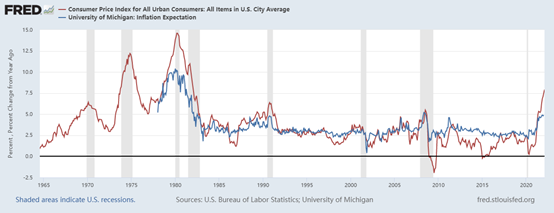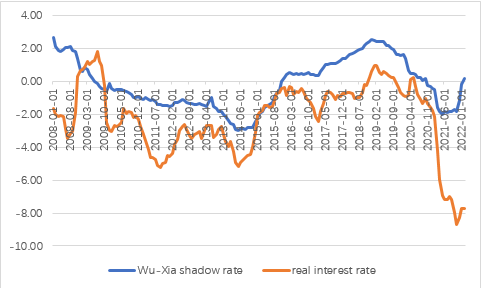Along with the strong indicators of economic activity and employment, the new record high inflation pushed US Federal Reserve to approve its first interest rate increase in more than three years. In addition, the FOMC expects to begin reducing its holdings of Treasury securities, agency debt and agency mortgage-backed securities at a coming meeting.
Given the full anticipation of the interest rate rise, the market has already absorbed the uncertainty and potential negative impacts via adjustments in advance. Many countries and regions have increased policy interest rates several times to deal with the inflation hike and the possible fluctuations in international capital flow. There are also economies that take actions with U.S. Federal Reserve. For example, Brazil, one of the most influential emerging market economies, raised the benchmark interest rate by 1% - the ninth consecutive raise since the covid-19 pandemic. Central banks in developed economies, like Bank of England, also followed US’ step.
Based on the current economic situation, especially the surges in inflation (Diagram 1), the current and subsequent interest rate hikes and the follow-up balance sheet reduction are imperative.

Diagram 1: CPI
Many economists and central bankers believe that, the inflation in the US has been stable for almost 30 years, and the main concern for the world’s major central banks was deflation instead of inflation. As a result, the probability that the inflation gets out of control is very low. Furthermore, they argue that the current inflation is caused by the dramatic increase of oil price, and this does not necessarily mean higher dollar price of other goods, as long as the oil supply recovers. But, will everything go as expected?

Diagram 2: FFR and real interest rate
First, whether the oil supply can recover quickly is uncertain. In contrast, the oil consumption is expected to have a strong seasonal surge in this spring and summer. The increase of demand is more convinced and faster than that of the oil supply.
Second, does high oil price necessarily mean higher inflation? According to Fed Chair Jerome Powell, the rule of thumb indicates that every $10 increase in the price of oil leads to a 0.2% increase in inflation. The price of crude oil futures increased from -37.63 USD in April 2020, to current approximately 100 USD - over 130 USD increase in 2 years. The quick calculation suggests that oil contributed less than 3% to the inflation. That is, the increases in the prices of other goods are not negligible. Meanwhile, the increase of average hourly earnings also reinforces the inflation expectation in the market. Compared to the inflation itself, the inflation expectations are more difficult for central banks.
Similar to the current situation, the shortage of supply had led to high oil price and a high inflation, in 1970s. Yet, the inflation expectations and excessive monetary easing pushed the temporary surges into persistent trends. To stabilize the volatile inflation expectations, US Federal Reserve had to react to inflation more aggressively during the 1980s. In comparison to the 1970s, what the Federal Reserve has done in the recent years is worse.
To bring the inflation back to a lower target value, the real interest rate should increase when inflation rises. However, the large negative values of the real rate during the 1970s indicates that the monetary policy was not sensitive enough against inflation. And this is also one of the major causes of the extremely high inflation during the 1970s and 1980s. It is obvious that the real interest rate in the recent years is even more negative than that of 1970s, which means the Federal Reserve has been overdoing the stimulus.

Diagram 3: shadow rate and real interest rate
The above analysis is based on the assumption that the federal fund rate is the sole monetary policy instrument. In fact, although the federal funds rate was constrained by the zero lower bound, the Federal Reserve implemented various unconventional monetary policy to stimulate the economy, such as asset purchases and forward guidance. We can use shadow rate to measure the unconventional monetary easing (the real shadow interest rate is the difference between the shadow rate and the CPI inflation). Diagram 3 shows that, under the unconventional monetary policy, the shadow rate is below 0, and the real shadow interest rate has declined even more.
The inflation has been stable in the past three decades. And Federal Reserve believes that the price increases since last year are caused by temporary shortage of supply. It is still important to stabilize market expectations, and prevent the temporary surges of inflation turning to persistent trends as it did in 1970s.
The past experience shows that every oil supply disruption was followed by recessions. Hikes in oil price can be harmful to the economy by shrinking the production in related industries, crowding out households’ expenditure on goods other than gasoline, and dampen consumer confidence. Although the Federal Reserve has not been facing the trade-off between inflation and economic growth, it is important to pay close attention to the indicators of economic activity.
References:
Hamilton, James. “Sanctions, energy prices, and the world economy,” 2022.
Wu, Jing Cynthia and Fan Dora Xia, “Measuring the Macroeconomic Impact of Monetary Policy at the Zero Lower Bound," Journal of Money, Credit, and Banking, 2016, 48(2-3), 253-291.
About the author:
Ji Zhang is currently an Associate Professor at PBC School of Finance at Tsinghua University. Ji's research areas are macroeconomics, monetary policy, fiscal policy, and unemployment theory. Her recent work is published in academic journals such as Journal of Monetary Economics, Review of Economics and Statistics, and Journal of International Economics.
Professor Zhang holds a B.A. in Economics and B.C. in Mathematics from Wuhan University, an M.A. in Economics from Shanghai University of Finance and Economics, and a Ph.D. in Economics from UC San Diego.